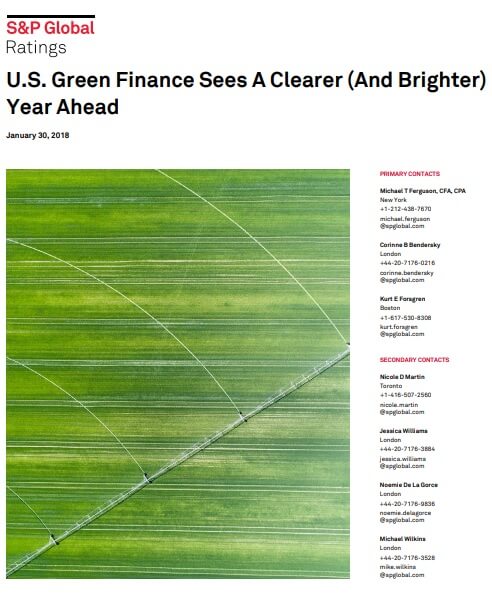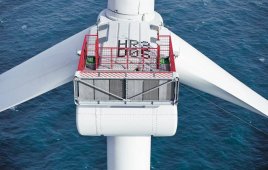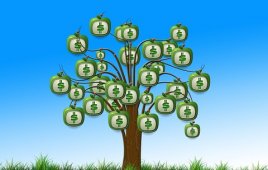This article comes from S&P Global Ratings. The full 13-page report is available here: https://goo.gl/BWfWyk
The grass should be even greener in 2018 for green finance globally. The green bond market, especially, remains  red hot worldwide. At long last, the proportion issued in the U.S. expanded significantly, though it remains eclipsed by China, France, and Germany. Even though the current administration has not shown an inclination to pursue carbon reduction policies and even has been slow to address infrastructure, a stated priority, a mixed group of municipalities, states, and large corporations are aggressively pushing forward with decarbonization efforts. The needs are enormous. Water, wastewater, and irrigation systems will require over $630 billion of investment through to 2033 to bring them up to modern standards, according to the U.S. Environmental Protection Agency. With such substantial funding requirements, we expect government agencies to call on a variety of financial tools to fund them.
red hot worldwide. At long last, the proportion issued in the U.S. expanded significantly, though it remains eclipsed by China, France, and Germany. Even though the current administration has not shown an inclination to pursue carbon reduction policies and even has been slow to address infrastructure, a stated priority, a mixed group of municipalities, states, and large corporations are aggressively pushing forward with decarbonization efforts. The needs are enormous. Water, wastewater, and irrigation systems will require over $630 billion of investment through to 2033 to bring them up to modern standards, according to the U.S. Environmental Protection Agency. With such substantial funding requirements, we expect government agencies to call on a variety of financial tools to fund them.
Key Takeaways
− The labeled U.S. green bond market grew substantially during 2017, but still trails several other countries where renewable growth and transportation improvements are propelling issuance.
− Uncertainty about U.S. regulatory policy may have contributed to this limited growth, but the revised U.S. tax code signed at year-end 2017 provided some clarity; however, it could also undermine the value of some critical tax credits.
− Longer term, ambitious infrastructure growth could be a source of green bond issuance.
− To date, we have performed Green Evaluations for seven issuances in the U.S., though not all are labeled green bonds. In the U.S., green bonds are more often than not issued on the local level. That’s because most green projects are financing renewable energy power plant and energy-efficient transportation.
Worldwide, labeled green bond issuance jumped to nearly $160 billion in 2017, with the figure also growing in the U.S. despite political headwinds (see chart 1). Knowing that municipalities and states sometimes cater to a different part of the investing community than traditional corporates, this prompts a question: Do these issuers find some kind of intrinsic benefit to issuing green bonds, or do investors prefer them to a degree that might convey a benefit? Climate Bonds Initiative price data to date do not yet suggest any kind of meaningful and consistent premium for green issuances over otherwise comparable non-green issuances. However, going forward, with a greater number of issuances, patterns may reveal themselves.
Tax reform: No real hit to green energy?
The green finance market breathed a sigh of relief once it realized that renewable tax credits were spared the budget ax. As the debate over tax reform came to a head in late 2017, the fate of the production tax credit (supporting wind) and the investment tax credit (supporting solar) hung in the balance, with early versions of the bill excluding these critical credits altogether and later versions curbing it to a large degree.
However, the final version of the bill, signed into law by President Donald J. Trump on Dec. 22, 2017, continued the credits – a surprising outcome, given that the law is thought to add substantially to the federal deficit. In a bill passed without a single Democratic vote, the continuation of the tax credit speaks to the enduring value of the credits as a tool for spurring renewable development that transcends partisan politics. Still, despite the critical credits being maintained for the moment, the revised tax code may have an indirect impact on the value of these credits. A lower corporate tax rate (with the marginal percentage down to 21% from 35%) could cause tax equity investment to be less valuable. With a limited number of tax equity investors as it is, the change to the tax code may affect how these projects are funded.
Filed Under: Financing




